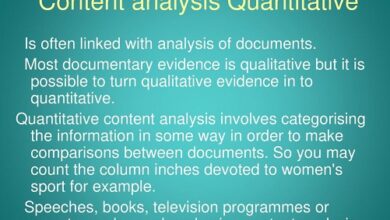What is Narrative analysis Uses Case Study Analysis of the Results
Narrative analysis is a form of qualitative research in which the researcher focuses on a topic and analyzes data collected from case studies, surveys, observations, or other similar methods. Researchers write their conclusions, then review and analyze them.
To conduct a narrative analysis, researchers must understand the background, setting, and social and cultural context of the research subjects. This allows the researchers to get a better idea of what the subjects mean in their narrative. This is especially true of context-rich investigations, where there are many hidden layers of meaning that can only be uncovered through deep understanding of the culture or setting.
Before beginning narrative research, researchers need to know as much as possible about their research subjects. They interview key informants and collect large amounts of text from them. They even use other sources, such as existing literature and personal recollections.
From this large base of information, the researchers choose a few cases that they consider to be good examples of what they want to talk about and analyze them in depth.
Uses of Narrative Analysis
Through this approach, researchers can gain a holistic view of the subject’s life and activities. It can show what motivates people and provide a better insight into the society in which subjects live by allowing researchers to see how individuals interact with each other.
Researchers have used it to study the indigenous peoples of various countries, such as the Maori of New Zealand.
It can be used in medicine. Researchers, for example, can study how doctors communicate with their patients during end-of-life care.
The narrative model has been used to explore the relationship between music and social change in East Africa.
Narrative research is being used to explore the differences in emotions experienced by different generations in Japanese society.
Through these examples of narrative analysis, we can see its nature and how it fills a gap left by other research methods.
Difference between Narrative Analysis and Case Study
Many people confuse narrative analysis in qualitative research with case studies. Here are some key differences between the two:
A case study examines a context in depth, while narrative analysis explores how a subject has acted in various contexts over time.
Case studies are often longer and more detailed, but rarely provide an overview of the subject’s life or experiences.
Narrative analysis implies that researchers observe various instances that span the life of the subject, thus providing a richer view of things.
Both tools can give similar results, but there are some differences that lead researchers to choose one or the other, or perhaps even both, in their research design.
Analysis of the Results in the Narrative Analysis
Once the narratives are collected, the researchers observe that certain patterns and themes emerge as they read and analyze the text. They write them down, compare them to other research on the topic, figure out how it all fits together, and then come up with a theory that might explain these findings.
Many social scientists have used narrative research as a valuable tool to analyze their concepts and theories. This is mainly because narrative analysis is a more comprehensive and multifaceted method. It helps researchers not only build a deeper understanding of their topic, but also find out why people act and react the way they do.
Storytelling is a central feature of narrative inquiry. The narrative interview is an interactive conversation. This process can be very intimate and sometimes provoke strong emotions in both parties. Therefore, this form of qualitative research is not suitable for everyone. The interviewer must know how to listen and understand the interview process. The interviewee must also feel comfortable in order to offer authentic accounts.
Understanding what type of research to use is a powerful tool for a manager. We can use narrative analysis in many ways. Narrative research is a multifaceted method that has the potential to show different results depending on the intentions of the researcher for the study of it.
Inductive method of narrative analysis
It is common for inductive narrative analysis methods to encode much larger blocks of text than traditional encoding methods. Narrative analysis differs from other qualitative analysis methods in that it attempts to keep individual narratives intact. In many coding methods, it is customary to divide an interviewee’s narrative into smaller chunks and group them by theme with statements from other interviewees. In this way, the personal narrative of the individual is broken.
Narrative analysis treats a complete story as the individual piece of data you are analyzing. Therefore, in the inductive method of narrative analysis, you must encode the entire text block of each of the research participants’ stories. This section of text is called the Narrative Block.
Entry and exit conversation
There are tricks to identifying narrative blocks in interviews with research participants. Riesssman recommends looking for inbound and outbound conversations. Participants can give you verbal cues when they start and end a story.
A story can begin with the phrases
“Once upon a time…”,
“Let me give you an example”
and “I will always remember when…”.
Similarly, you can detect the ending of stories with exit phrases like:
“This is how that ended…”
“That’s a pretty classic example of…”
and “and that was the end of that.”
You can’t always rely on “in and out talk” as they won’t always be used. Also, semi-structured interviews are not scripted. Narratives will not always exist as ordered narrative blocks. Participants can ramble and go off on tangents. But the narrative line can continue to exist. And through coding, a narrative is grouped that extends throughout an interview.
personal stories
Personal narratives come in a variety of forms.
news stories
A restricted story about a specific moment in time with a plot, characters, and setting, but does not encompass the entirety of a person’s life. Example: a research participant’s response to a single interview question
personal narrative
Personal narratives come from a lengthy interview or a series of lengthy interviews that offer a lengthy account of someone’s life. Example: a researcher conducting an in-depth interview or a series of in-depth interviews with a person over a long period of time.
full life story
Built from a set of interviews, observations and documents about the life of a person. Example: a historian who elaborates the biography of the life of a person from objects of the past.
Narrative data capture
Although humans naturally create narratives and stories by interpreting their own lives, certain data collection methods are more conducive to understanding research participants’ own sense of narrative. Semi-structured interviews, for example, give the interviewee the necessary space to go off on a narrative tangent and fully convey the internal stories of it. Highly structured interviews that follow a question-answer format or written surveys are less likely to capture narrative data.
Transcription of narrative data
As mentioned above, narrative analysis has two levels of interpretation. Researchers should not take interviews at face value as they are not limited to summarizing a research participant’s self-narrative. Rather, researchers must actively interpret how the interviewee created that self-narrative. Therefore, the narrative analysis emphasizes the verbatim transcription of the interviews, in which it is important to include pauses, filler words and extraneous expressions such as «um….».
Deductive method for narrative analysis
There are many story structuring frameworks. With a deductive method of narrative analysis, researchers can use a narrative structure framework and initial set of codes. This can be as simple as “Beginning”, “Middle” and “End”. In “Doing Narrative Research,” Patterson used the following codes for his narrative structure.
Summary: The central thesis of the story, summary
Orientation: Time, place, situation and characters
Complicated Action: Sequence of Events, Plot
Evaluation: How the narrator comments on the meaning
Resolution: Story Result
Coda (Italian term literally meaning “tail”): The end of the story
Similarly when performing a narrative analysis, we can use the Circle of History for our initial set of codes:
You – A character is in a comfort zone
Need – But they want something
Go – They enter an unknown situation
Search – Adapt to it
Find – Get what you want
Take/Pay – Pay a high price for it
Return – Return to your family situation
change – have changed
When using the deductive method, you may want to keep a record of the existing framework in a codebook.
Hybrid inductive and deductive narrative analysis
As usual in other qualitative analysis methods, it can be useful to combine the inductive and the deductive. In the case of narrative analysis, it is a question of first inductively encoding the narrative blocks of the transcripts. Within those narrative blocks, it is then deductively encoded using a story structure framework.
Step 1: Code the narrative blocks
Inductively code the narrative blocks you find in your interviews. Narrative blocks about similar life events should be coded with the same code.
For example, stories about how someone decided to have children could be coded as ‘Narratives about the decision to have children’.
Step 2: Group and read by vital event
Read all the narratives you have coded with the same “life event” code. As you do, note their similarities and differences. This is the beginning of your analysis.
Step 3: Create nested story structure codes
For each life event code, create and nest codes based on the framework of the story structure you have chosen. For example:
Narratives about the decision to have children (this is your inductively created life event code)
Summary (these codes are based on the structure of the story)
Orientation
complicated action
Evaluation
Resolution
coda
In more general terms:
code of life events
story structure 1
story structure 2
Now break up your narrative blocks, applying these story structure codes.
Step 4: Delve into the structure of the story
You can now classify each life event by its story structure code. For example, within the “narratives about the decision to have children”, you can focus on “Guidance”. In all the stories about the decision to have children, you can compare and contrast how different research participants oriented their stories. Similarities and differences can be noted as they are observed. Differences can be further coded to aid further analysis. For example, if it is common for participants to talk about their parents’ marital status, you can end up with the following code structure.
decide to have children
Summary
Orientation
parents divorce
parents are still together
etc…
Step 5: Compare across story structure
When dividing narrative blocks based on story structure, keep an eye on the overall narrative. Alternate between reading your narrative blocks as a whole and immersing yourself in each individual narrative structure code. Pay attention to how the story structure codes are related throughout a life event.
For example, participants who discussed their parents’ divorce may construct meaning differently than those whose parents stayed together. You can discover this finding by comparing Guidance with Assessment.
Step 6: Story of the Main Narrative
At the end of these steps, you will have fully explored each narrative block. You will have a deep understanding of how research participants narrate their lives. You will have seen how the stories of your participants are related, but also how they diverge. And along the way, you may have a theory as to why these stories diverge.
You can also divide a life event into two main stories and compare them. In our example above, we can write one main narrative from the perspective of participants whose parents divorced and another perspective from participants whose parents stayed together.


